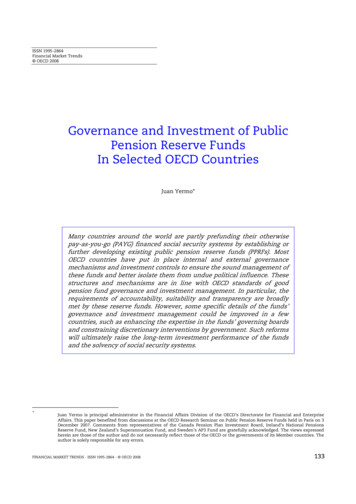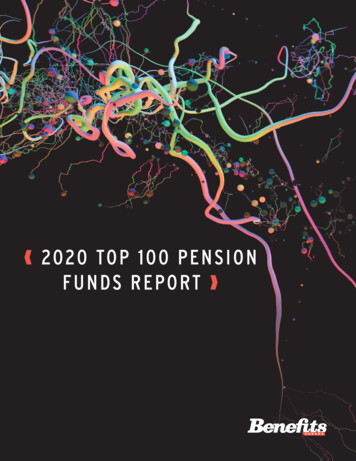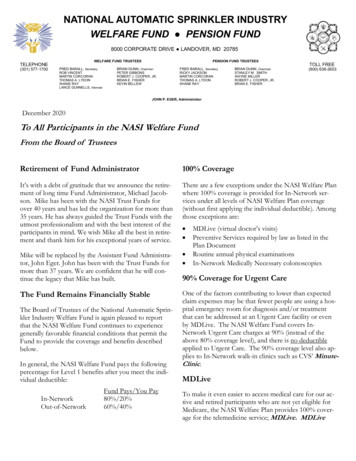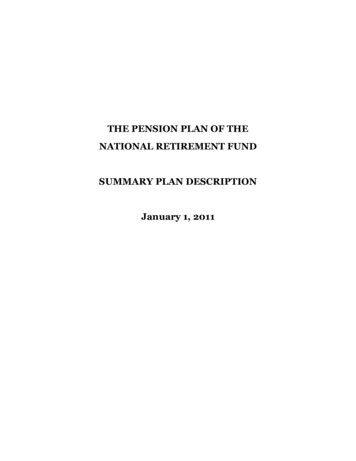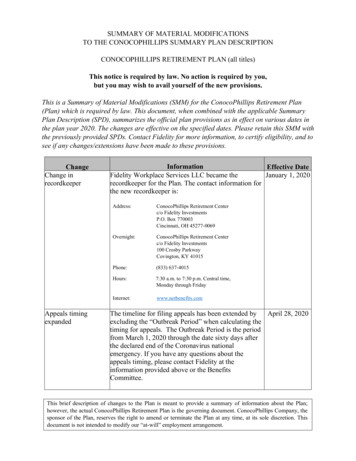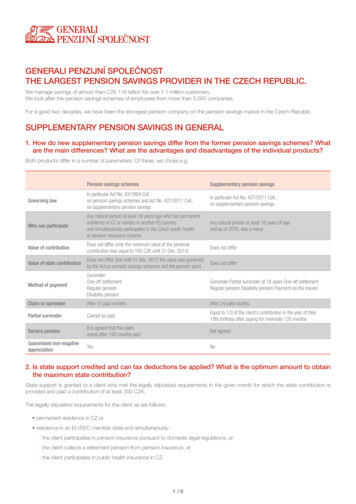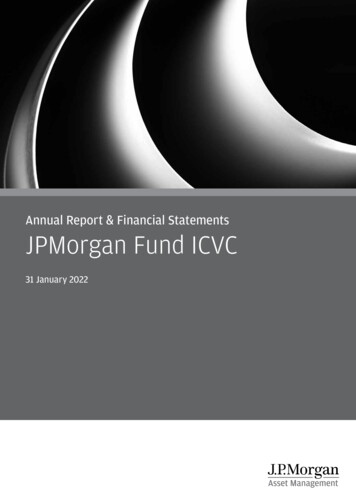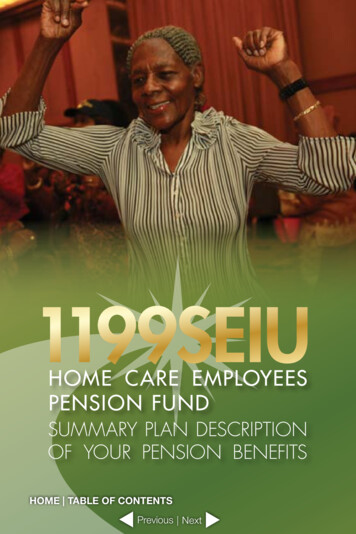
Transcription
HOME CARE EMPLOYEESPENSION FUNDSUMMARY PLAN DESCRIPTIONOF YOUR PENSION BENEFITSPrevious Next HOME TABLE OF CONTENTS
Previous Next HOME TABLE OF CONTENTS
July 2016Dear Pension Fund Participants and Retirees:We are pleased to provide you with this Summary Plan Description or “SPD,” whichexplains your pension benefits under the 1199SEIU Home Care Employees PensionFund, referred to in this booklet as the “Pension Fund” or “Fund.” The PensionFund is administered by a Board of Trustees, which consists of both Employer andUnion representatives. Their names and addresses are listed at the end of this SPD.Under various Collective Bargaining Agreements with your Union, 1199SEIU UnitedHealthcare Workers East, Employers make contributions to this Pension Fund toprovide pension benefits to you and other Employees covered by the Pension Fund.This SPD is a non-technical explanation of your pension benefits under the1199SEIU Home Care Employees Pension Fund. It is written to make it easierfor you to understand your rights and responsibilities under the Plan. The rulesand regulations of the Fund are set forth in its Plan Document and relateddocuments (collectively called the “Plan”).Please understand that no general explanation can adequately give you all of the detailsof the Plan. This general explanation does not change or expand or otherwise interpretthe terms of the Plan. To the extent that any of the information contained in this SPD isinconsistent with the official Plan documents, the provisions set forth in the official Plandocuments will govern in all cases. To obtain additional information about the operationof the Plan, visit the Pension Fund at 330 West 42nd Street, 10th Floor, New York, NY,10036, or call (646) 473-8666. Outside New York City, please call (800) 575-7771. Anywords that have an initial capital letter are defined terms in the Plan Document.Telephone conversations and other oral statements can easily bemisunderstood. Therefore, you should rely on the information provided inthe SPD and Plan Document rather than any oral explanation of the Plan’sprovisions. Your rights and duties under the Plan are determined solely byreferring to the Plan Document and Trust Agreement, as amended.The Plan is effective as of January 1, 2002, and amended as of January 1, 2015(except as specifically provided). The Plan has been amended for certain legislativechanges, such as the Pension Protection Act of 2006 (PPA). Any Participant whoretired or separated from service before January 1, 2015, should refer to theSPD in effect at the time of his or her retirement or separation from service.Upon written request to the Pension Fund at 330 West 42nd Street, 10th Floor,New York, NY 10036, you may obtain copies of the Plan, the Trust Agreementand other applicable Plan documents, including applicable Collective BargainingAgreements. These documents are also available for your examination at thePension Fund during regular business hours, upon written request.Previous Next1 HOME TABLE OF CONTENTS
We urge you to read this SPD carefully and keep it in a safe, accessible place, sothat it will be available for future reference. Pension Fund Counselors are availableto answer your questions, and we urge you to call for an appointment threeto six months prior to your planned retirement. They will explain your pensionbenefit and options, and help you through the application process. If you haveany questions, or want to make an appointment with a Pension Fund Counselor,call (646) 473-8666. Outside New York City, please call (800) 575-7771.The Board of TrusteesNEED HELP WITH THE SUMMARY PLANDESCRIPTION (“SPD”)?This SPD contains a summary in English of your Plan rights and benefits underthe 1199SEIU Home Care Employees Pension Fund.If you have difficulty understanding any part of this SPD, contact the Pension Fund at:1199SEIU Home Care Employees Pension Fund330 West 42nd Street, 10th FloorNew York, NY 10036You may also call the Pension Fund at (646) 473-8666, from 8:00 am to 6:00pm, Monday through Friday, or you may visit the Pension Fund from 8:00 amto 5:00 pm, Monday through Friday, for assistance. Outside New York City,please call (800) 575-7771.¿NECESITA AYUDA CON EL SUMARIO DEDESCRIPCIÓN DEL PLAN?Este folleto es un sumario en ingles de sus derechos y beneficios bajo el Fondode Pensiones para los Trabajadores de Cuidados en el Hogar de 1199SEIU.Si tiene problemas para entender cualquier parte de esta descripciónabreviada del plan, comuníquese con el Fondo de Pensiones al:1199SEIU Home Care Employees Pension Fund330 West 42nd Street, 10th FloorNew York, NY 10036Puede llamar al Fondo de Pensiones al (646) 473-8666, de 8:00 am a 6:00 pm,de lunes a viernes o puede visitar el Fondo de Pensiones de 8:00 am a 5:00pm de lunes a viernes para recibir ayuda. Fuera de la ciudad de Nueva York,llame al (800) 575-7771.Previous Next2 HOME TABLE OF CONTENTS
�基金會330 West 42nd Street, 10th FloorNew York, NY �至下午6點撥打退休基金會電話(646) ��協助。紐約市以外地區,請撥打(800) 575-7771。ВАМ ЧТО-ТО НЕПОНЯТНО В КРАТКОМОПИСАНИИ ПЛАНА?В данной брошюре дается краткое разъяснение на английском языкеваших прав и льгот по плану пенсионного обеспечения, м фондом профсоюза работников по уходу на дому 1199SEIU.Если вы испытываете трудности в понимании какой-либо части этогоКраткого описания плана (Summary Plan Description), обратитесь запомощью в Пенсионный фонд по следующему адресу:1199SEIU Home Care Employees Pension Fund330 West 42nd Street, 10th FloorNew York, NY 10036Вы также можете позвонить в Пенсионный фонд по телефону (646) 473-8666с понедельника по пятницу с 8:00 до 18:00 или посетить офис Фонда спонедельника по пятницу с 8:00 до 17:00. Если вы находитесь за пределамигорода Нью-Йорка, просим звонить по телефону (800) 575-7771.Previous Next3 HOME TABLE OF CONTENTS
CONTACT THE PENSION FUNDCall (646) 473-8666 to speak with a Pension Fund Representative or toschedule an appointment with a Pension Fund Counselor. Outside New YorkCity, please call (800) 575-7771.VISIT A WALK-IN MEMBER SERVICES CENTERManhattan330 West 42nd Street, 3rd FloorNew York, NY 10036Monday through Friday, 8:00 am to 6:00 pmPension Member Services:10th FloorMonday through Friday, 8:00 am to 5:00 pmOr call for an appointment: (646) 473-8666Bronx2501 Grand Concourse, 3rd FloorBronx, NY 10468Monday through Friday, 9:00 am to 5:00 pmPension Member Services:Third Thursday of each month, 10:00 am to 4:00 pmQueens97-30 64th RoadRego Park, NY 11374Monday through Friday, 9:00 am to 5:00 pmPension Member Services:Third Thursday of each month, 10:00 am to 4:00 pmBrooklyn25 Elm Place, 1st FloorBrooklyn, NY 11201Monday through Friday, 9:00 am to 5:00 pmPension Member Services:Third Thursday of each month, 10:00 am to 4:00 pmPrevious Next4 HOME TABLE OF CONTENTS
VISIT A WALK-IN MEMBER SERVICES CENTERStaten Island790 Port Richmond AvenueStaten Island, NY 10302Monday through Thursday, 9:00 am to 5:00 pmFriday, 8:00 am to 4:00 pmPension Member Services:First and third Thursdays of each month, 10:00 am to 4:00 pmLong Island100 Duffy Avenue, 3rd FloorHicksville, NY 11801Monday through Friday, 9:00 am to 5:00 pmPension Member Services:Monday through Friday, 8:30 am to 4:30 pmWestchesterBerkeley College Building99 Church Street, 4th FloorWhite Plains, NY 10601Monday, Wednesday and Thursday, 9:00 am to 5:00 pmPension Member Services:Monday through Friday, 9:00 am to 5:00 pmPrevious Next5 HOME TABLE OF CONTENTS
TABLE OF CONTENTSLetter from the Board of Trustees. . . . . . . . . . . . . . . . . . . . . . . . . . . . . . . . . . 1SECTION I – PARTICIPATION AND EARNING PENSION CREDITS. . . . . . . . . 9I. AWhen Am I Eligible to Participate in the Plan? . . . . . . . . . . . . . . . . 10I. BHow Is Pension Credit Accumulated? . . . . . . . . . . . . . . . . . . . . . . 11I. CHow Is Future Service Credit Earned? . . . . . . . . . . . . . . . . . . . . . . 12I. DHow Is Past Service Credit(for Service Before January 1, 1992) Earned? . . . . . . . . . . . . . . . . 14I. ECan I Get Past Service Credit If My EmployerBecame a Contributing Employer on or AfterJanuary 1, 2002?. . . . . . . . . . . . . . . . . . . . . . . . . . . . . . . . . . . . . . . 15I. FCan I Lose Past Service Credit Due to a Break-in-Service? . . . . . . 15I. GCan I Receive Pension Credit for TimeWhen I Did Not Work in Covered Employment? . . . . . . . . . . . . . . . 16I. HWhat Are “Years of Vesting Service”?. . . . . . . . . . . . . . . . . . . . . . . 17I. ICan I Receive Credit for AdditionalPeriods of Service for Vesting Purposes Only?. . . . . . . . . . . . . . . . 18SECTION II – BREAKS-IN-SERVICE . . . . . . . . . . . . . . . . . . . . . . . . . . . . . . . . 19II. ACan Pension Credit Be Lost or CanceledThrough a Break-in-Service Before I Am Vested? . . . . . . . . . . . . . 20II. BWhat Happens If I Am Vested,Incur a One-Year Break-in-Service,Earn Additional Pension Credits and Then Retire? . . . . . . . . . . . . . 21SECTION III – TYPES OF PENSIONS. . . . . . . . . . . . . . . . . . . . . . . . . . . . . . . . 23IIITypes of Pensions . . . . . . . . . . . . . . . . . . . . . . . . . . . . . . . . . . . . . . 24III. AWhen Am I Eligible for a Regular,Reduced or Vested Pension? . . . . . . . . . . . . . . . . . . . . . . . . . . . . . 24III. BHow Is a Pension Calculated at Age 65?. . . . . . . . . . . . . . . . . . . . . 25III. CWhen Am I Eligible for An Early Retirement Pension? . . . . . . . . . . 26III. DHow Is An Early Retirement Pension Calculated?. . . . . . . . . . . . . . 26Previous Next6 HOME TABLE OF CONTENTS
III. EWhen Am I Eligible for a Disability Pension?. . . . . . . . . . . . . . . . . . 27III. FHow Is a Disability Pension Calculated?. . . . . . . . . . . . . . . . . . . . . 27III. GHow Is My Benefit Rate of Pension Determined?. . . . . . . . . . . . . . 27SECTION IV – WORK AFTER RETIREMENT. . . . . . . . . . . . . . . . . . . . . . . . . . 29IV. AWill I Be Allowed to Work and Still ReceivePension Benefits from the Plan? . . . . . . . . . . . . . . . . . . . . . . . . . . . 30IV. BHow Will My Return to Work Affect My Pension? . . . . . . . . . . . . . . 31SECTION V – BENEFITS TO SURVIVORS. . . . . . . . . . . . . . . . . . . . . . . . . . . . 33V. AWhat Pension Options Are Available When I Retire?. . . . . . . . . . . . 34V. BAre There Any Benefits for a Surviving SpouseIf I Die Before My Pension Payments Begin? . . . . . . . . . . . . . . . . . 36V. CRules Regarding Pension Options. . . . . . . . . . . . . . . . . . . . . . . . . . 36V. DWhat Happens to the Joint and Survivor PensionIf My Spouse Dies or We Divorce Before My PensionPayments Begin?. . . . . . . . . . . . . . . . . . . . . . . . . . . . . . . . . . . . . . . 38V. EAre There Any Benefits If I Am Not Married andDie Before My Pension Payments Begin?. . . . . . . . . . . . . . . . . . . . 38V. FWhat Is a “60-Month Guarantee Pension”?. . . . . . . . . . . . . . . . . . . 39V. GWhen Am I Eligible to Receive a Lump-SumDistribution from the Plan? . . . . . . . . . . . . . . . . . . . . . . . . . . . . . . . 40SECTION VI – OTHER INFORMATION YOU SHOULD KNOW. . . . . . . . . . . . 41VIOther Information You Should Know. . . . . . . . . . . . . . . . . . . . . . . . 42VI. AApplying for Benefits. . . . . . . . . . . . . . . . . . . . . . . . . . . . . . . . . . . . 42VI. BDelayed and Retroactive Pension Starting Dates. . . . . . . . . . . . . . 43VI. CAppeal of a Denial of Benefits . . . . . . . . . . . . . . . . . . . . . . . . . . . . . 44VI. DAssignment of Benefits . . . . . . . . . . . . . . . . . . . . . . . . . . . . . . . . . . 46VI. EHow Benefits May Be Reduced, Delayed or Lost. . . . . . . . . . . . . . 47VI. FPlan Amendment or Termination . . . . . . . . . . . . . . . . . . . . . . . . . . . 47VI. GAuthority of the Plan Administrator . . . . . . . . . . . . . . . . . . . . . . . . . 48VI. HIncapacitation . . . . . . . . . . . . . . . . . . . . . . . . . . . . . . . . . . . . . . . . . 49Previous Next7 HOME TABLE OF CONTENTS
VI. ICompliance with Federal Law. . . . . . . . . . . . . . . . . . . . . . . . . . . . . 49VI. JRecovery of Overpayments. . . . . . . . . . . . . . . . . . . . . . . . . . . . . . . 49VI. KYour Disclosures to the Plan . . . . . . . . . . . . . . . . . . . . . . . . . . . . . . 50VI. LPlan Funding and Administration. . . . . . . . . . . . . . . . . . . . . . . . . . . 50VI. MCollective Bargaining Agreements/Contributing Employers. . . . . . 50VI. NTermination Insurance . . . . . . . . . . . . . . . . . . . . . . . . . . . . . . . . . . . 51SECTION VII – YOUR ERISA RIGHTS . . . . . . . . . . . . . . . . . . . . . . . . . . . . . . . 53VIIYour ERISA Rights. . . . . . . . . . . . . . . . . . . . . . . . . . . . . . . . . . . . . . 54VII. AGetting Information . . . . . . . . . . . . . . . . . . . . . . . . . . . . . . . . . . . . . 54VII. BFinding Out When You Qualify for a Pension. . . . . . . . . . . . . . . . . . 55VII. CFiduciary Responsibility. . . . . . . . . . . . . . . . . . . . . . . . . . . . . . . . . . 55VII. DEnforcing Your Rights . . . . . . . . . . . . . . . . . . . . . . . . . . . . . . . . . . . 56VII. EAssistance with Your Questions . . . . . . . . . . . . . . . . . . . . . . . . . . . 56VII. FImportant Notice . . . . . . . . . . . . . . . . . . . . . . . . . . . . . . . . . . . . . . . 57SECTION VIII – GENERAL INFORMATION. . . . . . . . . . . . . . . . . . . . . . . . . . . . 59VIII. AGeneral Information. . . . . . . . . . . . . . . . . . . . . . . . . . . . . . . . . . . . . 60VIII. B Joint Board of Trustees. . . . . . . . . . . . . . . . . . . . . . . . . . . . . . . . . . 63PLAN DOCUMENT. . . . . . . . . . . . . . . . . . . . . . . . . . . . . . . . . . . . . . . . . . . . . . . 65Introduction. . . . . . . . . . . . . . . . . . . . . . . . . . . . . . . . . . . . . . . . . . . . . . . . . . 661Definitions . . . . . . . . . . . . . . . . . . . . . . . . . . . . . . . . . . . . . . . . . . . . 672Participation. . . . . . . . . . . . . . . . . . . . . . . . . . . . . . . . . . . . . . . . . . . 723Pension Eligibility and Amounts. . . . . . . . . . . . . . . . . . . . . . . . . . . . 734Accumulation of Pension Credits. . . . . . . . . . . . . . . . . . . . . . . . . . . 805Joint And Survivor Pension. . . . . . . . . . . . . . . . . . . . . . . . . . . . . . . 866Applications, Benefit Payments and Retirement. . . . . . . . . . . . . . . 937Miscellaneous . . . . . . . . . . . . . . . . . . . . . . . . . . . . . . . . . . . . . . . . 1128Amendments. . . . . . . . . . . . . . . . . . . . . . . . . . . . . . . . . . . . . . . . . 116Previous Next8 HOME TABLE OF CONTENTS
SECTION I – PARTICIPATION ANDEARNING PENSION CREDITSA. When Am I Eligible to Participate in the Plan?B. How Is Pension Credit Accumulated?C. How Is Future Service Credit Earned?D. How Is Past Service Credit (for Service Before January 1, 1992) Earned?E. Can I Get Past Service Credit If My Employer Became a ContributingEmployer on or After January 1, 2002?F.Can I Lose Past Service Credit Due to a Break-in-Service?G. Can I Receive Pension Credit for Time When I Did Not Work inCovered Employment?H. What Are “Years of Vesting Service”?I.Can I Receive Credit for Additional Periods of Service for VestingPurposes Only?Previous Next9 HOME TABLE OF CONTENTS
SECTION I. AWHEN AM I ELIGIBLE TO PARTICIPATE IN THE PLAN?Effective January 1, 2002, the 1199 Home Care Industry Pension Fund (“HCIPF”)merged into the Home Care Industry Local 32B-32J-144 SEIU Pension Fund(“32BJ Fund”). The merged Fund is called the 1199SEIU Home Care EmployeesPension Fund (“Home Care Pension Fund” or “Fund”). If you were a Participantin the HCIPF or 32BJ Fund on January 1, 2002, you automatically became aParticipant in this Fund — you don’t need to sign up or notify anyone.You will become eligible to participate in the Fund on the January 1st or July 1st(whichever comes first) following the first 12-consecutive-month period in whichyou have worked at least 1,000 Hours of Service. An Hour of Service is anyhour for which you are paid, or entitled to payment, by the Employer, such asworking time, paid vacations and paid sick leave.Your working time in Covered Employment is important because it is used todetermine your eligibility to participate in the Fund, and the amount of yourbenefit. Covered Employment means all employment with your Employer afterthe start of the Contribution Period.The Contribution Date is the date that your Employer first became obligatedto make contributions to this Fund on your behalf. It is the first day of theContribution Period — the period of time during which your Employer isobligated to make contributions to this Fund on your behalf.For example:Ms. Hall began working for a Contributing Employer on March 1, 2012. ByNovember 30, 2012, she worked a total of 1,200 Hours of Service. Since sheworked more than 1,000 Hours of Service during the 12-consecutive-month periodwhich ended on February 28, 2013, Ms. Hall became a Participant on July 1, 2013.NOTE: If you worked in Covered Employment before January 1, 1992, you are coveredby a special rule which automatically made you a Participant on January 1, 1992,provided you earned Pension Credit on or after January 1, 1992. In this case, youwere not required to work 1,000 Hours of Service to become a Participant. If youbecame a Participant because of this special rule, you still need to earn FutureService Credits of at least .25 credits to earn a pension.Previous Next10 HOME TABLE OF CONTENTS
SECTION I. BHOW IS PENSION CREDIT ACCUMULATED?Pension Credit is accumulated in two ways, depending on whether it is earnedbefore or after the Contribution Date. Pension Credits earned before theContribution Date are called Past Service Credits. Pension Credits earned afterthe Contribution Date are called Future Service Credits.The number of Pension Credits you have accumulated determines your eligibilityfor a monthly pension benefit and the amount of the benefit which you areeligible to receive. You earn Pension Credits according to the number of hoursyou work.As a Participant, you are entitled, subject to the Break-in-Service rules inSection II, to have all credit counted for benefit calculation purposes from yourfirst day of eligible employment. For purposes of calculating your pension, themaximum number of Pension Credits is 25.For example:In your first year working for a Contributing Employer, you only worked 600hours instead of the 1,000 hours necessary to become a Participant. If yousubsequently become a Participant, the .50 Pension Credits earned based onthe 600 hours in your first year will be counted toward your pension.Previous Next11 HOME TABLE OF CONTENTS
SECTION I. CHOW IS FUTURE SERVICE CREDIT EARNED?You earn Pension Credits based on your total hours of Covered Employmentworked during a calendar year, as follows:STARTING ON JANUARY 1, 2015HOURS OF SERVICE IN COVERED EMPLOYMENTIN A CALENDAR YEARPENSION CREDIT1,000 or more hours1.00From 750 to 999 hours.75From 500 to 749 hours.50From 250 to 499 hours.25Under 250 hours0JANUARY 1, 2014 – DECEMBER 31, 2014The maximum Pension Credits that can be earned for Plan Year 2014 is .25Pension Credits.JANUARY 1, 2012 – DECEMBER 31, 2013The maximum Pension Credits that can be earned combined for Plan Years 2012and 2013, shall be the greater of: (a) .75 Pension Credits; or (b) the amount of thePension Credits accrued on or after January 1, 2012, and prior to June 1, 2012.JANUARY 1, 2002 – DECEMBER 31, 2011HOURS OF SERVICE IN COVERED EMPLOYMENTIN A CALENDAR YEARPENSION CREDIT1,000 or more hours1.00From 750 to 999 hours.75From 500 to 749 hours.50From 250 to 499 hours.25Under 250 hours0Previous Next12 HOME TABLE OF CONTENTS
JANUARY 1, 1992 – DECEMBER 31, 2001If you were a Participant in the 32BJ Fund, you received Pension Credits basedon the chart before this paragraph. If you were a Participant in the HCIPF, youreceived Pension Credits based on total Hours of Service worked during acalendar year, as follows:HOURS OF SERVICE IN COVERED EMPLOYMENTIN A CALENDAR YEARPENSION CREDIT1,500 or more hours1.00From 1,250 to 1,499 hours.75From 1,000 to 1,249 hours.625From 750 to 999 hours.50Under 750 hours0Previous Next13 HOME TABLE OF CONTENTS
SECTION I. DHOW IS PAST SERVICE CREDIT(FOR SERVICE BEFORE JANUARY 1, 1992) EARNED?IF YOU WERE A 32BJ FUND PARTICIPANT BEFORE JANUARY 1, 2002If you worked for a Contributing Employer that had a Collective BargainingAgreement in effect with the Union on January 1, 1992, you will receive .25 PastService Credits for each calendar quarter prior to January 1, 1992, during whichyou worked at least 250 Hours of Service for that Employer in a job categorycovered under that Collective Bargaining Agreement.IF YOU WERE A FORMER HCIPF PARTICIPANT BEFORE JANUARY 1, 2002If you worked for a Contributing Employer that had a Collective BargainingAgreement in effect with the Union on October 1, 1991, you will receive onePast Service Credit for each calendar year prior to January 1, 1992, in which youworked 1,500 or more Hours of Service. (The HCIPF did not provide for partialPast Service Credit. Therefore, you will not receive Past Service Credits for anyyear in which you did not work at least 1,500 Hours of Service.) The maximumnumber of Past Service Credits you may be eligible to receive is 10.Previous Next14 HOME TABLE OF CONTENTS
SECTION I. ECAN I GET PAST SERVICE CREDIT IF MY EMPLOYERBECAME A CONTRIBUTING EMPLOYER ON ORAFTER JANUARY 1, 2002?If you worked for your agency before it became a Contributing Employer to theFund and the agency became a Contributing Employer on or after January 1, 2002,you may earn Past Service Credits for the time you worked before your agencystarted participating in the Fund. You are eligible to receive Past Service Credits if: The Plan’s actuary has determined that granting Past Service Credit toEmployees of your Employer will not create an unfunded liability*; and You are employed in a job category covered by a Collective BargainingAgreement with an agency on the date the agency first becomes required tomake contributions to the Fund; and You earn at least two Future Service Credits after you earn your first Hourof Service.If you are eligible to receive Past Service Credit, you will receive one PastService Credit for each calendar year in which you had 1,000 or more Hours ofService. The maximum number of Past Service Credits allowed is 10.* You may contact the Pension Fund to determine whether your bargaining unitwill be eligible to receive Past Service Credit.SECTION I. FCAN I LOSE PAST SERVICE CREDIT DUE TO ABREAK-IN-SERVICE?If you were a Participant in either the HCIPF or the 32BJ Fund before January 1,1992, and your employment was interrupted by a one-year period during whichyou did not work at least 500 Hours of Service, it is considered a Break-inPast-Service (as described in Section II.A), and you will not receive Past ServiceCredits for any service preceding the Break.Previous Next15 HOME TABLE OF CONTENTS
SECTION I. GCAN I RECEIVE PENSION CREDIT FOR TIME WHEN IDID NOT WORK IN COVERED EMPLOYMENT?There are certain periods when you may receive Pension Credit, just as if youwere employed in Covered Employment, even if you were not actually employedin Covered Employment.Periods of absence from Covered Employment will be credited if they were theresult of disability arising from Covered Employment for which benefits werepaid under Workers’ Compensation, or the New York Disability Benefits Law.No more than six months on and after January 1, 2002, will be credited underthis rule for each separate absence. This provision only applies if you have priorPension Credits.You may be entitled to continue to earn Pension Credits and Years of VestingService while you are on a leave of absence for Qualified Military Service asdefined under the Plan and federal law. To receive credit: you must give advancenotice, if possible, that you will be absent from Covered Employment due tomilitary service; your leave of absence must not exceed five years; you mustreceive an honorable or general discharge from military service or active duty;and you must apply for reemployment within a reasonable period of time afteryour discharge or return from active duty.For additional information, please refer to the Plan or contact the Pension Fundat (646) 473-8666. Outside New York City, please call (800) 575-7771.Previous Next16 HOME TABLE OF CONTENTS
SECTION I. HWHAT ARE “YEARS OF VESTING SERVICE”?A Year of Vesting Service is a calendar year in which you work 1000 hours ormore in Covered Employment.In order to become eligible for a pension, you must become vested in the Plan. Onceyou become vested, you have a non-forfeitable right to a pension upon retirement.In order to become vested, you must earn five Pension Credits or five Years ofVesting Service. But if you left Covered Employment before January 1, 1997, youmust have earned 10 Pension Credits or 10 Years of Vesting Service to becomevested. At least .25 Pension Credits must be earned during the Contribution Period.Pension Credits are earned according to the schedule(s) in Section I.C. SeeSection I.I for more details about vesting in a pension.For example:Mrs. Johnson worked in Covered Employment for eight years from 2008 through2015 with the hours shown in the chart below. The Fund determined that shehad earned 5.25 Pension Credits and five Years of Vesting Service as follows:YEARHOURS OFSERVICEPENSIONCREDITYEARS OFVESTING 3501.001Previous Next17 HOME TABLE OF CONTENTS
SECTION I. ICAN I RECEIVE CREDIT FOR ADDITIONAL PERIODSOF SERVICE FOR VESTING PURPOSES ONLY?Any period that you worked in a non-covered job for the same Employer eitherimmediately before or immediately after (or both) working in a job title coveredby this Plan, is counted toward your becoming vested (but only toward yourbecoming vested.) You will not receive Pension Credits that will be counted inyour final benefit calculation for any time worked in a non-covered job.For the period of January 1, 2012, through December 31, 2014, you maycontinue to earn Years of Vesting Service even though you are not earningPension Credits (see Section I.C).For example:Mrs. Garcia worked as a home care worker from January 2007 until March2013 when her client passed away. For a variety of reasons, she was notassigned a new case until early 2014. But, in the meantime, Mrs. Garciaperformed some clerical activities in the Agency’s bookkeeping department.She only had 380 Hours of Service as a home care worker in 2013, but hadanother 900 Hours of Service as a part-time clerical worker. According to thisspecial rule, she will be granted the equivalent of one Vesting Credit for 2013for purposes of vesting only, based on her total during 2013 of 1,280 hours.Previous Next18 HOME TABLE OF CONTENTS
SECTION II – BREAKS-IN-SERVICEA. Can Pension Credit Be Lost or Canceled Through a Break-in-Service BeforeI Am Vested?B. What Happens If I Am Vested, Incur a One-Year Break-in-Service, EarnAdditional Pension Credits and Then Retire?Previous Next19 HOME TABLE OF CONTENTS
SECTION II. ACAN PENSION CREDIT BE LOST OR CANCELEDTHROUGH A BREAK-IN-SERVICE BEFORE I AM VESTED?Before you become vested, you may lose Pension Credits you’ve already earnedif you stop working in Covered Employment, or don’t work enough hours forlong stretches of time. When this happens, you may have a Permanent Breakin-Service. You may also incur a one-year Break-In-Service if there is acalendar year in which you fail to work in Covered Employment for 500 or morehours.In order to become vested, you must earn five Pension Credits or five Years ofVesting Service. But if you left Covered Employment before January 1, 1997, youmust have earned 10 Pension Credits or 10 Years of Vesting Service to becomevested. At least .25 Pension Credits must be earned during the Contribution Period.You Will Have a Permanent Break-in-Service If: On or after January 1, 1997, you have less than five Pension Credits andhave five consecutive one-year Breaks-in-Service.For example, suppose you earned three Pension Credits and then incurredfive or more consecutive one-year Breaks-in-Service. At that point, yourprevious credit is permanently cancelled. On or after January 1, 1992, through December 31, 1996, you had fiveor less Pension Credits and had five or more consecutive one-year Breaksin-Service, or you had at least six but less than 10 Pension Credits andthe number of your consecutive one-year Breaks-in-Service equaled orexceeded your number of Pension Credits. Prior to January 1, 1992, you will have a Permanent Break-in-Service withregard to Past Service if there is a calendar year prior to 1992 in which youfailed to work at least 500 hours in Covered Employment.A Permanent Break-in-Service prior to January 1, 1992, means all PastService Credits for years prior to the year you worked less than 500 hours inCovered Employment are lost.A Permanent Break-in-Service after January 1, 1992, means that you lose allPension Credits and Years of Vesting Service earned before your one-yearBreak-in-Service.Previous Next20 HOME TABLE OF CONTENTS
If you later return to work in Covered Employment after a Permanent Breakin-Service, the Pension Fund will treat you as a new Participant. In otherwords, you’ll have no accrued Vesting or Pension Credits when you restartparticipation in the Plan.WHAT IS NOT A BREAK-IN-SERVICEYou will not have a one-year Break-in-Service if your absence from CoveredEmployment is the result of: Family and M
This SPD is a non-technical explanation of your pension benefits under the 1199SEIU Home Care Employees Pension Fund. It is written to make it easier for you to understand your rights and responsibilities under the Plan.
